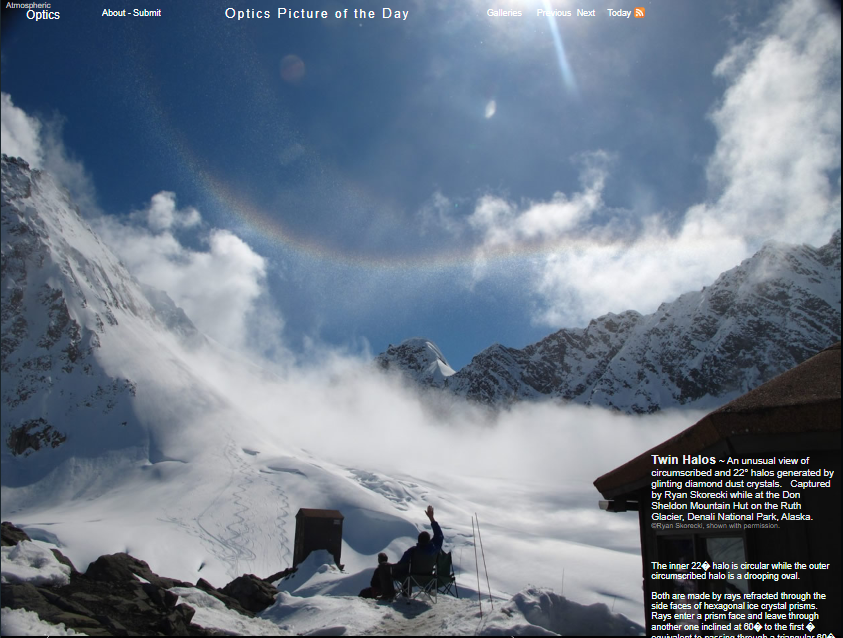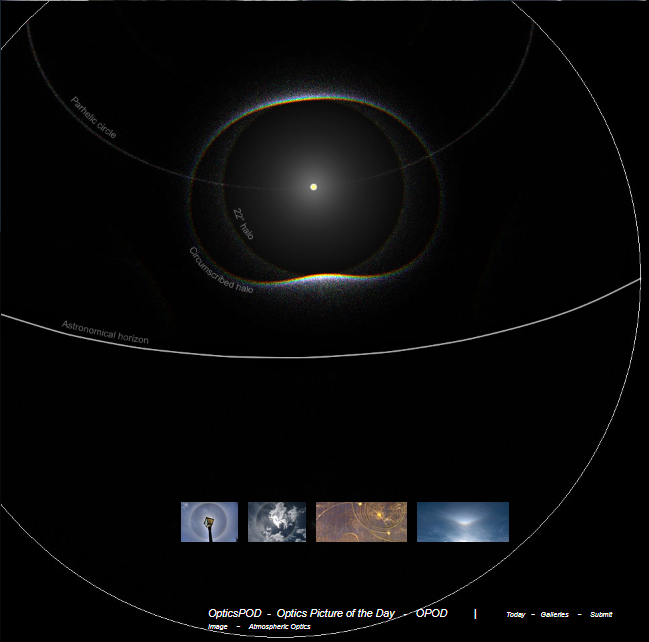OPOD - Denali Halos
OPOD - Denali Halos: A Spectacular Display of Atmospheric Optics
Have you ever witnessed a mesmerizing atmospheric phenomenon that left you in awe? In the realm of atmospheric optics, there are countless captivating displays that can occur under specific conditions. One such extraordinary sight is the "Denali Halos" observed in Denali National Park, Alaska. In this blog post, we will delve into the details of this unique phenomenon and unravel the science behind its formation.
The Enigmatic Twin Halos
The Denali Halos are a remarkable combination of two distinct halos - the circular inner 22° halo and the drooping oval-shaped outer circumscribed halo. These halos are created when sunlight passes through glinting diamond dust crystals suspended in the air. This occurrence was beautifully captured by photographer Ryan Skorecki while he was at the Don Sheldon Mountain Hut on the Ruth Glacier in Denali National Park.
Understanding the Formation of the Halos
Both the inner 22° halo and the outer circumscribed halo are formed due to the refraction of sunlight through hexagonal ice crystal prisms. Rays of sunlight enter one face of a prism and exit through another inclined at an angle of 60°. However, their formation mechanisms differ significantly.
-
The inner 22° halo is likely generated by crystal clusters tumbling in the air rather than the commonly attributed "randomly aligned pencils" or column crystals. The exact nature of these crystal clusters and their behavior in the atmosphere remains a subject of ongoing research and speculation.
-
On the other hand, the circumscribed halo, also known as the higher sun cousin of the upper and lower tangent arcs, is produced by column crystals. These crystals are oriented by aerodynamic drag forces as they descend slowly relative to local air currents. The drag aligns the crystals so that their long axes are nearly horizontal.
Exploring the Parhelic Circle
In addition to the twin halos, the oriented column crystals also give rise to another fascinating phenomenon known as the parhelic circle. This circular arc of light is a by-product of the aligned column crystals and can be observed alongside the halos. The parhelic circle adds an extra layer of intrigue to the already captivating display of atmospheric optics in the Denali skies.
A Glimpse into HaloSim Ray Tracing
To further comprehend the intricacies of the Denali Halos, researchers have utilized advanced simulation techniques. A HaloSim ray tracing calculation, shown on the left side of the image, provides a visual representation of the twin halos and the parhelic circle. This computational approach allows scientists to gain insights into the precise paths of light rays and understand the underlying physics governing these atmospheric phenomena.
Conclusion
The Denali Halos offer a mesmerizing spectacle that showcases the beauty and complexity of atmospheric optics. The combination of the circular inner 22° halo, the drooping oval-shaped outer circumscribed halo, and the accompanying parhelic circle creates a truly enchanting visual experience. While scientists continue to unravel the mysteries surrounding the formation of these halos, witnessing such a breathtaking display reminds us of the wonders that nature has to offer. So, keep your eyes to the sky and be ready to be captivated by the astonishing atmospheric phenomena that unfold above us.

Twin Halos ~ An unusual view of circumscribed and 22° halos generated by glinting diamond dust crystals. Captured by Ryan Skorecki while at the Don Sheldon Mountain Hut on the Ruth Glacier, Denali National Park, Alaska. ©Ryan Skorecki, shown with permission.
The inner 22� halo is circular while the outer circumscribed halo is a drooping oval.
Both are made by rays refracted through the side faces of hexagonal ice crystal prisms. Rays enter a prism face and leave through another one inclined at 60� to the first � equivalent to passing through a triangular 60� prism.
There the similarity ends. The 22� halo forming entities are probably crystal clusters that tumble in the air and almost certainly not the �randomly aligned pencils� or column crystals usually accused of this halo�s formation.
The circumscribed halo � the higher sun cousin of the upper and lower tangent arcs � is the product of column crystals. These crystals are always oriented by aerodynamic drag forces as they drift slowly downwards relative to local air currents. The drag aligns the crystals so that their long axes are to within a degree or so � and often much closer � to horizontal.
At left a HaloSim ray tracing calculation shows the two halos and a by-product of the oriented column crystals, the parhelic circle.

Note: this article has been automatically converted from the old site and may not appear as intended. You can find the original article here.
Reference Atmospheric Optics
If you use any of the definitions, information, or data presented on Atmospheric Optics, please copy the link or reference below to properly credit us as the reference source. Thank you!
-
<a href="https://atoptics.co.uk/blog/opod-denali-halos/">OPOD - Denali Halos</a>
-
"OPOD - Denali Halos". Atmospheric Optics. Accessed on April 19, 2024. https://atoptics.co.uk/blog/opod-denali-halos/.
-
"OPOD - Denali Halos". Atmospheric Optics, https://atoptics.co.uk/blog/opod-denali-halos/. Accessed 19 April, 2024
-
OPOD - Denali Halos. Atmospheric Optics. Retrieved from https://atoptics.co.uk/blog/opod-denali-halos/.